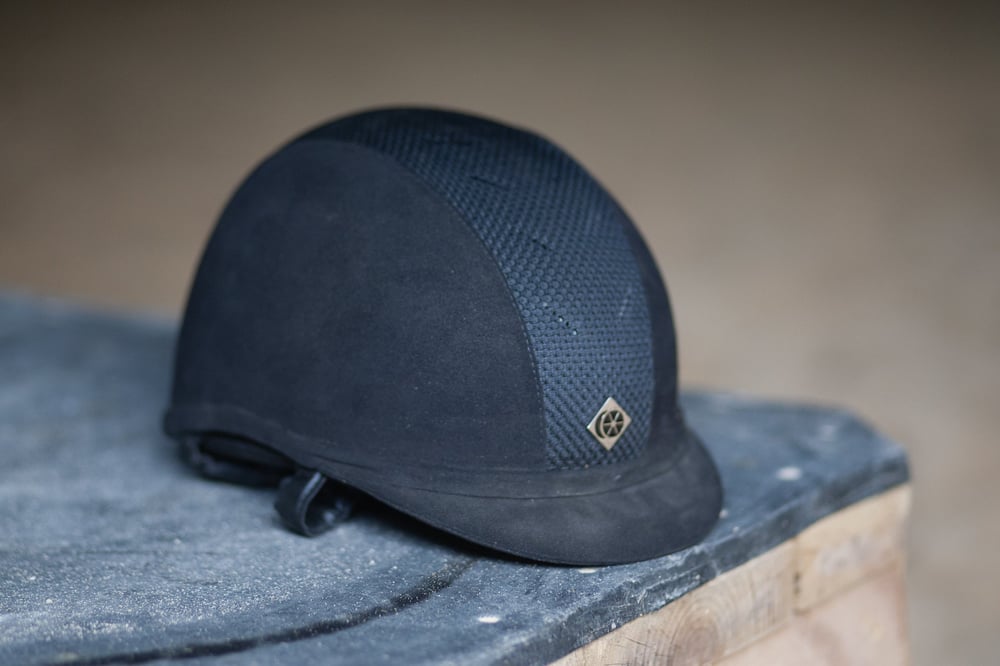
Virginia Tech Helmet Lab Unveils STAR Rating Results for Equestrian Helmets
Lexington, Ky.—Dec. 7, 2022—The U.S. Hunter Jumper Association is pleased to share the Virginia Tech Helmet Lab's results of the STAR evaluation system for equestrian helmets. As part of fundraising efforts, the USHJA Board of Directors donated $100,000 towards the initiative and helped raise enough funds alongside other equestrian organizations and individuals to reach Virginia Tech’s $450,000 goal in just six months.

Over the past two years, the team of researchers from Virginia Tech's Department of Biomedical Engineering and Mechanics analyzed over 100 videos of riders falling off horses. Precisely measured the hardness of the sand, dirt, grass and synthetic surfaces underfoot at equestrian events. Dragged dummy heads and necks and pendulums and other equipment—and boxes and boxes of helmets—out to Virginia Tech’s equestrian facilities to simulate falls.
Then the team of researchers took all that data back to the lab to recreate those events in a series of controlled, quantitative tests. They used those tests to assess 40 equestrian helmets from different manufacturers. The result is the first set of equestrian helmet ratings from the renowned Virginia Tech Helmet Lab.
Equestrian sports attract about 30 million participants in the U.S. every year and account for 50,000 trips to the emergency room for concussions and other brain injuries. That’s more than any other sport in America.
“Most people are surprised to learn that,” said Stefan Duma, the Harry Wyatt Professor of Engineering and the Helmet Lab’s founder. “But when you think about the height of a horse and the distance a rider would fall, that translates into a high impact energy.”
If a rider’s head hits the ground in a fall like that, the helmet can determine whether the rider makes it through without an injury. That’s why the Helmet Lab wanted to determine which helmets perform better than others.
Of the 40 models included in this initial set of ratings, two earned the top score of five stars. Eleven earned four, and the rest earned three or below. Price isn’t necessarily a predictor of quality: one of the two five-star helmets retails for $460 and the other for $58. The ratings apply to falls that occur during walking, trotting, galloping, jumping and the wide variety of other horse movements that can occur in equestrian disciplines including Hunter/Jumper, Eventing and Dressage.
The lab’s extensive testing shed more light on what happens during real impacts in the equestrian arena. It also illuminated some gaps between the required safety standards these helmets have to pass before going on the market and the actual impacts they’re subjected to when a rider is wearing them.
“Standards for equestrian helmets are typically based on severe impacts,” Duma said. “What we found is that a lot of riders come off at lower velocities, and many helmets are too stiff to effectively cushion those softer impacts. The helmets that perform better are able to deal with different energy levels.”
Virginia Tech’s ratings also go beyond the existing standards by using a formula that considers the rotational acceleration that occurs when a rider’s head hits the ground, in addition to linear acceleration.
This is the lab’s ninth major ratings release since researchers began rating helmets in 2011. They have tested and rated helmets for varsity, youth and flag football; soccer; cycling; hockey; snow sports; and whitewater sports, transforming the science of sports safety by giving athletes, parents and coaches unbiased, quantitative data they can use to choose the safest equipment. The ratings for each sport come together through a meticulous process of translating metrics from real-world head impacts into evidence-based test methods that assess helmet performance under realistic conditions.
“Every sport is different. Football is played on grass, hockey is played on ice—those are very different from falling on dirt and sand,” Duma said. “With every sport we look at, we go through detailed analysis to make sure that the biomechanics we’re testing relate specifically to those athletes. For these ratings, we determined what the acceleration profile would look like for a rider falling on the ground. Then we take that trace and bring it into the lab and recreate it, to make sure that our testing matches what a rider would experience if they fell off a horse.”
The pendulum impactor used for the equestrian helmet testing sits in a lab space outfitted with custom-built test equipment in the basement of the headquarters of the Institute for Critical Technology and Applied Science, an interdisciplinary investment institute where Duma is the director. When the pendulum strikes a headform protected by one of the helmets being tested, sensors inside the headform record the blow. Each helmet model was tested at three impact locations and two impact speeds that are representative of real-world falls.
The research was funded by private donors, led by equestrian enthusiast and philanthropist Jacqueline Mars and three national equestrian foundations: the U.S. Hunter Jumper Association, the U.S. Equestrian Federation and the U.S. Eventing Association.
“I hope this new work will save more brains and more lives,” Mars said. “I just had a friend seriously injured when a horse fell on him and his head in a helmet hit the hard road. This is wonderful work for all riders, and I am grateful to Virginia Tech and the Helmet Lab as well as to all who sponsored this work.”
“The importance of helmet safety is of the highest importance to our health and well-being and that of equestrian sport,” said Mary Knowlton, president of the USHJA. “The USHJA donated $100,000 to support the Virginia Tech Helmet Lab research efforts, and our pledge to support Virginia Tech’s work is not only a commitment to furthering research and technology in this field but also a commitment to our equestrian community to help make it safer for all involved.”
“This is a monumental time for safety in equestrian sport,” said USHJA Safety Committee Chair Joe Dotoli, who spearheaded helmet research fundraising efforts through the USHJA and the Equestrian Helmet Safety Initiative. “Through the Virginia Tech Helmet Lab’s research and findings, equestrians now have a lot more information to make better-informed purchases and helmet manufacturers can make better and safer helmets.”
“The U.S. Equestrian Federation is not only fully committed to the welfare and protection of horses but also of our people," said David O'Connor, chief of sport at the U.S. Equestrian Federation. "The launch of the rating system developed through the helmet research done by the Virginia Tech Helmet Lab is an exponential step in improving equipment in the world that will reduce the risk of injuries. We are proud to have supported this research and congratulate the Virginia Tech Helmet Lab on their progressive work for the benefit of all equestrians.”
Duma emphasized how fortunate the lab has been to receive this kind of support. “Their gifts made these ratings possible,” he said.
The equestrian ratings, and those for the other sports the lab has studied, are available on the Virginia Tech Helmet Ratings website, along with the corresponding test methods. That allows companies to use the protocols to evaluate designs and prototypes, optimizing a new helmet’s safety profile before it ever hits the market.
“The ratings show consumers which helmets are better than others,” Duma said. “But the real key is that this provides a framework for manufacturers to make better helmets. They can look at our analysis, recreate that testing and optimize their helmet design to make the best helmet possible.”
In the years since the lab released its first helmet ratings, Duma has seen that when manufacturers have access to an evidence-based tool for improving safety, over time they’ll produce more and more effective helmets.
“When we released our first ratings for football more than one year ago, there was only one five-star helmet,” Duma said. “Now there are more than 20.”
He expects to see that pattern play out for equestrian helmets, too.
“A lot of these helmets don’t test well right now, but we expect the manufacturers to make improvements,” he said. “That’s going to be better for consumers as well as manufacturers. Ultimately, we hope to reduce the number of injuries.”
Learn more about the Virginia Tech Helmet Lab and its equestrian helmet ratings here.
Edited press release from Virginia Tech
Photo: Rachel Sowinski/USHJA



